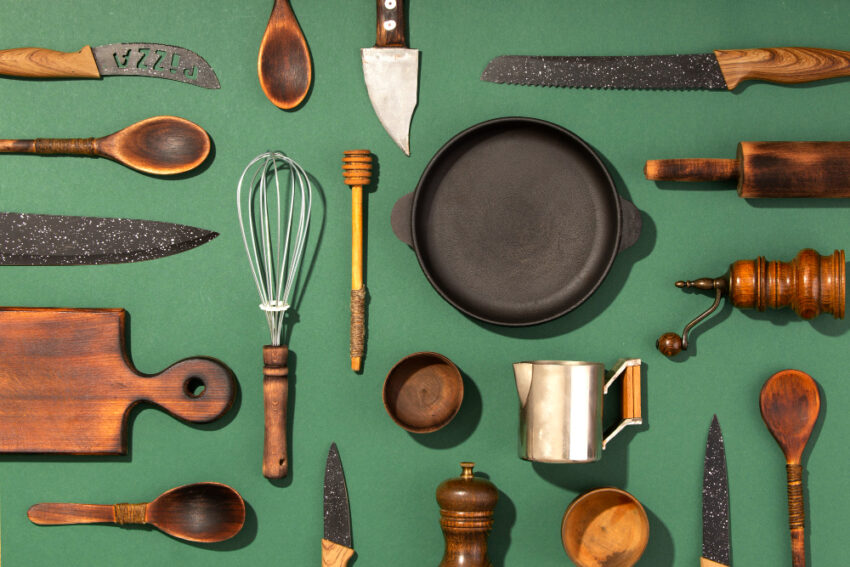Introduction
Cooking is not just a necessity; it’s an art form that allows us to explore flavors, experiment with ingredients, and create delicious dishes. Whether you’re a seasoned home cook or just starting, understanding cooking tips and techniques is essential to elevating your culinary skills. In this comprehensive guide, we’ll delve into the world of cooking, from kitchen essentials to advanced techniques, helping you become a master in your own kitchen.
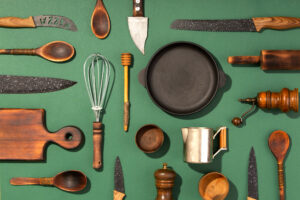
Table of Contents
Kitchen Essentials
A well-equipped kitchen is the cornerstone of successful cooking. To get started, you need the right tools and ingredients.
Must-have Utensils and Equipment:
Knives: Invest in a good chef’s knife and a paring knife. Properly sharpened knives make slicing and dicing a breeze.
Pots and Pans: A versatile set of pots and pans in various sizes is essential. Ensure you have a non-stick skillet, a heavy-bottomed saucepan, and a large stockpot.
Cutting Boards: Use separate cutting boards for meat and vegetables to prevent cross-contamination.
Measuring Tools: Accurate measurements are crucial for baking. Invest in measuring cups and spoons.
Stocking Your Pantry
Essential Ingredients: Keep staples like flour, sugar, salt, and olive oil stocked at all times. They are the building blocks of many dishes.
Herbs and Spices: A well-rounded spice collection adds depth and flavor to your cooking. Start with the basics like salt, pepper, paprika, and oregano.
Staple Grains and Legumes: Rice, pasta, beans, and lentils are versatile ingredients for a variety of dishes.
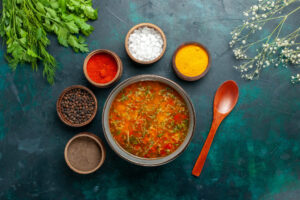
Cooking Tips and Techniques (Preparetion)
Before you start cooking, it’s crucial to prepare your ingredients properly.
Knife Skills:
Basic Knife Cuts: Learn to dice, chop, julienne, and mince. These fundamental techniques improve your cooking efficiency and presentation.
Proper Knife Maintenance: Keep your knives sharp with a honing rod or whetstone. Dull knives are more dangerous and less effective.
Mise en Place:
The Importance of Organization: “Mise en place” means “everything in its place.” Set up your ingredients and tools before you start cooking to avoid chaos later.
Time-saving Benefits: Preparing everything in advance allows you to focus on cooking techniques and flavor development.
Ingredient Preparation:
Peeling and Chopping Vegetables: Master the art of peeling and cutting vegetables for even cooking.
Preparing Proteins: Trim and portion meat or fish properly to ensure they cook evenly.
Grating and Zesting: Grating cheese or zesting citrus adds unique flavors and textures to your dishes.
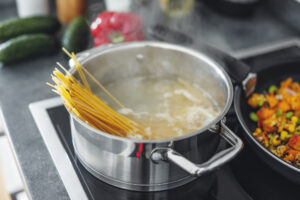
Cooking Methods
Cooking Tips and Techniques: Cooking methods play a significant role in the outcome of your dishes. Understanding when and how to use them is key.
Overview of Various Cooking Methods
Baking: Ideal for cakes, bread, and casseroles, Heat surrounds the food, cooking it evenly.
Roasting: Similar to baking but often used for meats and vegetables, usually at higher temperatures.
Grilling: Adds a smoky flavor and grill marks to food. Great for meats, vegetables, and even fruits.
Sautéing and Stir-frying: Quick cooking in a small amount of oil, perfect for vegetables and thin cuts of meat.
Boiling and Simmering: Used for pasta, rice, and simmering soups and stews. Boiling is at a rolling boil, while simmering is gentler.
Understanding Heat Control:
High Heat vs. Low Heat: High heat sears and caramelizes, while low heat gently cooks and develops flavors.
Searing vs. Simmering: Searing creates a crust, while simmering allows flavors to meld.
Choosing the Right Method for Different Dishes:
Proteins: Steaks and chops are best grilled or pan-seared, while tougher cuts benefit from slow braising or roasting.
Vegetables: Roasting or grilling enhances the natural sweetness, while sautéing retains crunch and color.
Baked Goods: Precise baking temperatures are crucial for cakes, cookies, and bread.
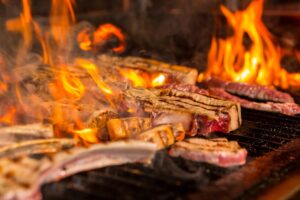
Flavor Enhancement
Creating well-seasoned and flavorful dishes is at the heart of cooking.
Seasoning and Spices:
Balancing Flavors: Achieve a harmonious balance of sweet, salty, sour, and umami flavors in your dishes.
Common Spice Pairings: Understand which spices complement each other for different cuisines and dishes.
Sauces and Condiments:
Homemade vs. Store-bought: Homemade sauces and condiments offer freshness and customization.
Quick Sauce Recipes: Learn easy-to-make sauces like tomato, béchamel, or vinaigrette.
The Role of Fats:
Cooking with Oils and Fats: Different fats, like olive oil, butter, or lard, impact flavor and texture differently.
Enhancing Flavor and Texture: Fats can add richness and moisture to dishes.
Presentation and Plating
A well-plated dish not only tastes great but also looks enticing.
Importance of Visual Appeal:
First Impressions: Presentation influences your perception of a dish’s taste.
Plating Techniques:
Balance and Composition: Consider colors, shapes, and heights when arranging food on a plate.
Garnishes and Decoration: Fresh herbs, microgreens, or a drizzle of sauce can elevate your presentation.
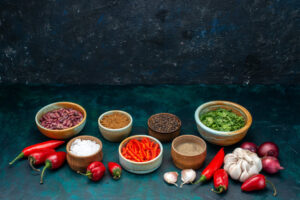
Troubleshooting
Mistakes happen in the kitchen. Knowing how to recover can save a meal.
Common Cooking Mistakes
Overcooking: Adjusting cook times or finishing in the oven can rescue overcooked dishes.
Underseasoning: Taste and adjust seasonings as you cook to avoid blandness.
Burning: Pay close attention to heat and use non-stick cookware to prevent burning.
How to Salvage Dishes
Dilution: For over-seasoned dishes, dilute with unsalted liquid or more ingredients.
Texture Adjustments: Pureeing or adding cream can fix texture issues.
Learning from Your Mistakes
Embrace failure: Mistakes are opportunities for growth. Reflect on what went wrong to improve next time.
Specialized Cooking Tips and Techniques
If you want to take your cooking to the next level, consider advanced and ethnic cooking techniques.
Advanced Cooking Methods
Sous-vide: Precise temperature control for perfectly cooked proteins.
Smoking: Infuse smoky flavors into meats and vegetables.
Fermentation: Experiment with homemade pickles, kimchi, and sourdough bread.
Ethnic Cooking Techniques
Asian Stir-frying: Quick, high-heat cooking with a focus on fresh ingredients.
Italian Pasta-making: Learn to make fresh pasta and pair it with authentic sauces.
Mexican Salsa Preparation: Master the art of crafting diverse salsas from scratch.
FAQs
1. What is the most important tool in the kitchen for a beginner cook?
A good chef’s knife is arguably the most essential tool for a beginner cook. It can handle a wide range of cutting tasks and makes food preparation much more efficient and enjoyable. Invest in a quality knife and learn how to maintain it properly.
2. How can I prevent my food from sticking to the pan when I’m sautéing or frying?
To prevent food from sticking, make sure your pan is hot before adding oil or other ingredients. Use an appropriate amount of oil (usually a thin layer) and ensure it’s evenly distributed. Additionally, consider using non-stick cookware for delicate items and avoid overcrowding the pan, which can trap moisture and cause sticking.
3. What’s the best way to season food for optimal flavor?
Balancing flavors is key to great-tasting dishes. Experiment with a combination of salt, pepper, herbs, and spices. Taste your food as you cook and adjust seasonings gradually to achieve the desired taste. Also, don’t forget the importance of acidity (lemon juice, vinegar) and sweetness (sugar, honey) in balancing flavors.
4. I often overcook or undercook my dishes. How can I improve my cooking timing?
Cooking timing can be tricky, but it improves with experience. Start by following recipes closely and using timers. Pay attention to visual and tactile cues, such as the color and texture of the food. Over time, you’ll develop a sense of timing that suits your preferences.
Conclusion
Cooking is a journey of exploration and creativity. By mastering essential cooking tips and techniques, you’ll not only gain confidence in the kitchen but also discover the joy of preparing and sharing delicious meals with loved ones. So roll up your sleeves, gather your ingredients, and let your culinary adventure begin. With practice and a dash of passion, you’ll soon be creating culinary masterpieces that leave your taste buds dancing with delight.
#Cooking Tips and Techniques, #Cooking Tips and Techniques

